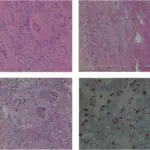
Photomicrographs of anaplastic oligodendroglioma and arteriovenous malformation (AVM) histology (a) anaplastic oligodendroglioma showing uniform cellularity, uniformly round nuclei, and perinuclear halos. This section shows classic delicate microvasculature, although microvascular proliferation was seen in other areas. Inset highlights an atypical mitotic figure of which many were identified (H and E; original magnification, ×200). (b) Secondary features of oligodendroglioma include scattered microcalcifications (center of the image) and clonal nodules of heightened cellularity (right side of image) (H and E original magnification, ×100). (c) Irregular large vessels of the AVM with intervening cellular oligodendroglioma (*) (H and E original magnification, ×20). (d) Irregularly contoured vessels of the AVM filled with black granular embolization material. An intimal cushion is identified in one of the fibrotic vessel walls (*) (H and E original magnification, ×50)Arteriovenous malformation within an isocitrate dehydrogenase 1 mutated anaplastic oligodendroglioma.
Lai G, Muller KA, Carter BS, Chen CC - Surgical neurology international (2015). Not Altered. CC.
Oligodendrogliomas is a tumor that develops from oligodendrocytes.
What is the Pathology of Oligodendrogliomas?
Etiology: The cause of Oligodendrogliomas is not known.
Genes involved: IDH mutation and 1p19q codeletion.
Pathogenesis: Expansion of clonal oligodedrycytes.
Histology: The histology associated with oligodendrogliomas shows regular cells with spherical nuclei containing finely granular chromatin surrounded by a halo of cytoplasm that is described as a “fried egg” appearance.
How does Oligodendrogliomas Present?
Patients with oligodendrogliomas are predominantly males, most often in people between the ages of 35 and 44. The symptoms, features, and clinical findings associated with Oligodendrogliomas include seizures, memory issues, headaches, and balance problems.
How is Oligodendroglioma Diagnosed?
Oligodendrogliomas are diagnosed by neurological exam, imaging, and biopsy.
How is Oligodendroglioma Treated?
Oligodendrogliomas can be treated by surgical resection with or without chemotherapy or radiation therapy.
What is the Prognosis of Oligodendrogliomas?
The prognosis of Oligodendrogliomas is fair.



